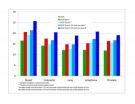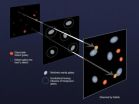(Press-News.org) Washington, DC – Tinnitus appears to be produced by an unfortunate confluence of structural and functional changes in the brain, say neuroscientists at Georgetown University Medical Center (GUMC).
The phantom ringing sounds heard by about 40 million people in the U.S. today are caused by brains that try, but fail to protect their human hosts against overwhelming auditory stimuli, the researchers say in the January 13th issue of Neuron. They add that the same process may be responsible for chronic pain and other perceptual disorders.
The researchers say that the absence of sound caused by hearing loss in certain frequencies, due to normal aging, loud-noise exposure, or to an accident, forces the brain to produce sounds to replace what is now missing. But when the brain's limbic system, which is involved in processing emotions and other functions, fails to stop these sounds from reaching conscious auditory processing, tinnitus results.
"We believe that a dysregulation of the limbic and auditory networks may be at the heart of chronic tinnitus," says the study's lead investigator, Josef P. Rauschecker, PhD, a neuroscientist. "A complete understanding and ultimate cure of tinnitus may depend on a detailed understanding of the nature and basis of this dysregulation."
Tinnitus isn't curable, although antidepressants appear to help some patients, as does the use of masking noise to diminish focus on the ringing sensations.
Using functional Magnetic Resonance Imaging (fMRI), the Georgetown researchers tested 22 volunteers, half of whom had been diagnosed with chronic tinnitus. They found that moderate hyperactivity was present in the primary and posterior auditory cortices of tinnitus patients, but that the nucleus accumbens exhibited the greatest degree of hyperactivity, specifically to sounds that were matched to frequencies lost in patients.
The nucleus accumbens is part of the corticostriatal circuit, which is involved in evaluation of reward, emotion, and aversiveness, says Rauschecker. "This suggests that the corticostriatal circuit is part of a general 'appraisal network' determining which sensations are important, and ultimately affecting how or whether those sensations are experienced," he says. "In this study, we provide evidence that these limbic structures, specifically the nucleus accumbens and the ventromedial prefrontal cortex, do indeed differ in the brains of individuals with tinnitus."
Functional lapses in these same areas have also been implicated to altered mood states and to chronic pain. "Both of these conditions may also involve the inability to suppress unwanted sensory signals," Rauschecker says.
Based on their findings, the researchers argue that the key to understanding tinnitus lies in understanding how the auditory and limbic systems interact to influence perception – be it sound, emotions, pain, etc.
###
Grant support was provided by the National Institute on Deafness and Other Communication Disorders, the Tinnitus Research Consortium, the Tinnitus Research Initiative, and the Skirball Foundation.
The authors report no related financial interests.
About Georgetown University Medical Center
Georgetown University Medical Center is an internationally recognized academic medical center with a three-part mission of research, teaching and patient care (through MedStar Health). GUMC's mission is carried out with a strong emphasis on public service and a dedication to the Catholic, Jesuit principle of cura personalis -- or "care of the whole person." The Medical Center includes the School of Medicine and the School of Nursing and Health Studies, both nationally ranked, the world-renowned Georgetown Lombardi Comprehensive Cancer Center and the Biomedical Graduate Research Organization (BGRO). In fiscal year 2009-2010, GUMC accounted for 79 percent of Georgetown University's extramural research funding.
END
Based on growth and aging of the U.S. population, medical expenditures for cancer in the year 2020 are projected to reach at least $158 billion (in 2010 dollars) – an increase of 27 percent over 2010, according to a National Institutes of Health analysis. If newly developed tools for cancer diagnosis, treatment, and follow-up continue to be more expensive, medical expenditures for cancer could reach as high as $207 billion, said the researchers from the National Cancer Institute (NCI), part of the NIH. The analysis appears online, Jan. 12, 2011, in the Journal of the National ...
(PHILADELPHIA) –The discovery that high levels of high-density lipoprotein (HDL) cholesterol (the "good cholesterol") is associated with reduced risk of cardiovascular disease has fostered intensive research to modify HDL levels for therapeutic gain. However, recent findings have called into question the notion that pharmacologic increases in HDL cholesterol levels are necessarily beneficial to patients. Now, a new study from researchers at the University of Pennsylvania School of Medicine shows that a different metric, a measure of HDL function called cholesterol efflux ...
A new study identifies a molecule that is a critical regulator of neuron survival after ischemic brain injury. The research, published by Cell Press in the January 13 issue of the journal Neuron, may lead to new therapies that reduce damage after a stroke or other injuries that involve an interruption in blood supply to the brain.
Ischemic brain injury is damage caused by a restriction in blood supply. Neuronal death after an interruption in the supply of oxygen and glucose involves a complex cascade of pathological events and, although previous research has identified ...
NIH-funded researchers were able to eliminate tinnitus in a group of rats by stimulating a nerve in the neck while simultaneously playing a variety of sound tones over an extended period of time, says a study published today in the advance online publication of the journal Nature. The hallmark of tinnitus is often a persistent ringing in the ears that is annoying for some, debilitating for others, and currently incurable. Similar to pressing a reset button in the brain, this new therapy was found to help retrain the part of the brain that interprets sound so that errant ...
SEATTLE – Astronomers who survey galaxies in the distant universe are getting some unexpected help from gravity, according to a new study.
In a presentation at the American Astronomical Society meeting this week and a related paper in the current issue of the journal Nature, researchers say that as many as 20 percent of the most distant galaxies currently detected appear brighter than they actually are, because of an effect called "strong gravitational lensing."
The discovery could change astronomers' notions of how galaxies formed in the early universe.
Haojing Yan, ...
Teeth and bone are important and complex structures in humans and other animals, but little is actually known about their chemical structure at the atomic scale. What exactly gives them their renowned toughness, hardness and strength? How do organisms control the synthesis of these advanced functional composites?
Now, using a highly sophisticated atomic-scale imaging tool on a sea creature's tooth, two Northwestern University researchers have peeled away some of the mystery of organic/inorganic interfaces that are at the heart of tooth and bone structure. They are the ...
New British-led research shows that starting treatment of blood pressure with two medicines rather than the one produces better and faster results and fewer side effects – findings that could change clinical practice world-wide.
The study, published in the Lancet, challenges popular medical practice for the treatment of high blood pressure. The research was led by Cambridge in collaboration with the Universities of Dundee, Glasgow and the British Hypertension Society.
Doctors usually start treatment with one medicine and then add others over a period of months, if needed, ...
Targeted nerve stimulation could yield a long-term reversal of tinnitus, a debilitating hearing impairment affecting at least 10 percent of senior citizens and up to 40 percent of military veterans, according to an article posted in the Jan. 12 online edition of Nature.
Researchers Dr. Michael Kilgard and Dr. Navzer Engineer from The University of Texas at Dallas and University-affiliated biotechnology firm MicroTransponder report that stimulation of the vagus nerve paired with sounds eliminated tinnitus in rats. A clinical trial in humans is due to begin in the next ...
WHAT:
Adding new evidence to the debate on the best treatment for middle-ear infections, or acute otitis media, in young children, clinical researchers at the Children's Hospital of Pittsburgh of the University of Pittsburgh Medical Center have found antibiotics to be more effective than a placebo in relieving symptoms. These findings appear in the January 13th issue of the New England Journal of Medicine. The study was funded by the National Institute of Allergy and Infectious Diseases, part of the National Institutes of Health.
Most American children with middle-ear ...
PASADENA, Calif.—Astronomers at the California Institute of Technology (Caltech), University of Illinois at Urbana-Champaign (UIUC), and University of Hawaii (UH) have discovered 16 close-knit pairs of supermassive black holes in merging galaxies.
The discovery, based on observations done at the W. M. Keck Observatory on Hawaii's Mauna Kea, is being presented in Seattle on January 12 at the meeting of the American Astronomical Society, and has been submitted for publication in the Astrophysical Journal.
These black-hole pairs, also called binaries, are about a hundred ...


